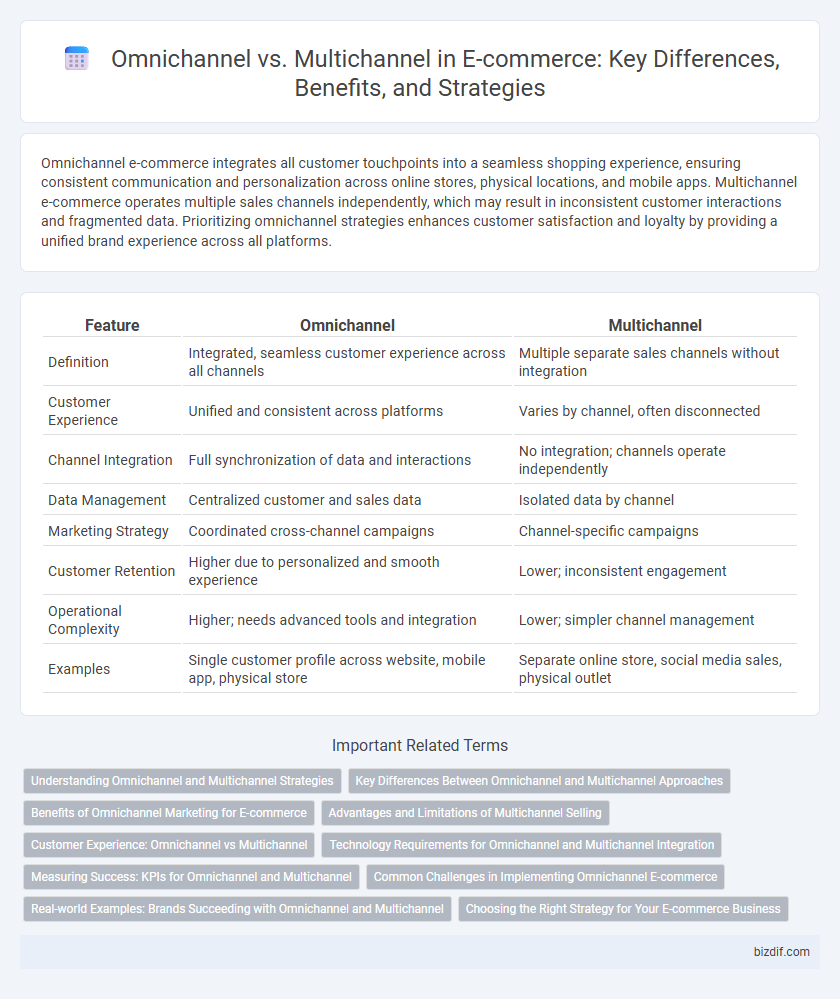Omnichannel e-commerce integrates all customer touchpoints into a seamless shopping experience, ensuring consistent communication and personalization across online stores, physical locations, and mobile apps. Multichannel e-commerce operates multiple sales channels independently, which may result in inconsistent customer interactions and fragmented data. Prioritizing omnichannel strategies enhances customer satisfaction and loyalty by providing a unified brand experience across all platforms.
Table of Comparison
| Feature | Omnichannel | Multichannel |
|---|---|---|
| Definition | Integrated, seamless customer experience across all channels | Multiple separate sales channels without integration |
| Customer Experience | Unified and consistent across platforms | Varies by channel, often disconnected |
| Channel Integration | Full synchronization of data and interactions | No integration; channels operate independently |
| Data Management | Centralized customer and sales data | Isolated data by channel |
| Marketing Strategy | Coordinated cross-channel campaigns | Channel-specific campaigns |
| Customer Retention | Higher due to personalized and smooth experience | Lower; inconsistent engagement |
| Operational Complexity | Higher; needs advanced tools and integration | Lower; simpler channel management |
| Examples | Single customer profile across website, mobile app, physical store | Separate online store, social media sales, physical outlet |
Understanding Omnichannel and Multichannel Strategies
Omnichannel strategies integrate multiple sales channels into a seamless customer experience, ensuring consistent interaction across online stores, physical locations, and social media platforms. Multichannel strategies involve using multiple channels independently to reach customers, often resulting in fragmented experiences. Understanding the distinction helps e-commerce businesses optimize customer journey mapping and improve engagement by aligning channels effectively.
Key Differences Between Omnichannel and Multichannel Approaches
Omnichannel e-commerce integrates all customer touchpoints into a seamless and consistent shopping experience across online, offline, mobile, and social platforms, while multichannel operates multiple separate sales channels independently. Customer data synchronization and personalized interactions are core to omnichannel strategies, driving higher engagement and retention compared to multichannel approaches that often lack unified customer insights. The omnichannel model prioritizes holistic brand experience and cross-channel continuity, whereas multichannel focuses on maximizing sales through discrete, isolated channels.
Benefits of Omnichannel Marketing for E-commerce
Omnichannel marketing enhances e-commerce by providing a seamless and consistent customer experience across all platforms, leading to higher customer satisfaction and retention rates. It integrates online and offline channels, allowing personalized communication and unified inventory management, which increases operational efficiency and boosts sales. Brands using omnichannel strategies report up to 91% greater year-over-year customer retention compared to multichannel approaches.
Advantages and Limitations of Multichannel Selling
Multichannel selling allows businesses to reach customers across various platforms such as online marketplaces, social media, and physical stores, increasing overall market presence and sales opportunities. However, limitations include fragmented customer experiences and challenges in maintaining consistent branding and inventory management across channels. This approach often requires more complex coordination and may hinder the ability to deliver seamless, personalized interactions compared to omnichannel strategies.
Customer Experience: Omnichannel vs Multichannel
Omnichannel e-commerce enhances customer experience by providing a seamless and integrated interaction across all channels, allowing customers to switch effortlessly between online and offline platforms with consistent branding and personalized service. Multichannel approaches offer multiple standalone channels, but lack synchronization, leading to fragmented experiences and inconsistent messaging. Prioritizing omnichannel strategies results in higher customer satisfaction, increased loyalty, and improved lifetime value through uniform engagement across touchpoints.
Technology Requirements for Omnichannel and Multichannel Integration
Omnichannel integration requires advanced technology platforms that enable seamless data synchronization across all customer touchpoints, including inventory management, CRM, and real-time analytics, ensuring a unified shopping experience. Multichannel integration often relies on separate systems for each channel, leading to fragmented data and limited visibility into customer behavior. Investing in APIs, cloud-based solutions, and AI-driven tools is essential for omnichannel systems to provide consistent personalization and operational efficiency.
Measuring Success: KPIs for Omnichannel and Multichannel
Measuring success in omnichannel e-commerce relies on KPIs such as customer lifetime value (CLV), seamless cross-channel conversion rates, and unified customer satisfaction scores that reflect a consistent experience across all touchpoints. Multichannel KPI focus includes channel-specific metrics like individual sales volume, website traffic per platform, and separate customer engagement rates, emphasizing isolated performance. Effective data integration tools and real-time analytics platforms are crucial for accurate tracking and comparison of omnichannel versus multichannel strategies.
Common Challenges in Implementing Omnichannel E-commerce
Implementing omnichannel e-commerce often faces challenges such as integrating diverse sales platforms to create a seamless customer experience and consolidating inventory management across online and offline channels. Businesses struggle with data synchronization issues that impact real-time stock visibility and personalized marketing efforts. Ensuring consistent branding and customer service quality across multiple touchpoints further complicates the adoption of an effective omnichannel strategy.
Real-world Examples: Brands Succeeding with Omnichannel and Multichannel
Nike's omnichannel strategy integrates its online store, mobile app, and physical retail locations, offering personalized shopping experiences and seamless inventory management. Walmart excels in a multichannel approach by maintaining distinct online and offline sales channels, catering to different customer preferences without fully integrating them. Sephora's omnichannel success is highlighted by its cohesive experience through its website, mobile app, and in-store consultations, driving higher customer engagement and loyalty.
Choosing the Right Strategy for Your E-commerce Business
Selecting the right strategy between omnichannel and multichannel is crucial for e-commerce success, with omnichannel providing a seamless, integrated customer experience across all platforms, while multichannel focuses on selling through multiple independent channels. An omnichannel approach enhances customer retention and boosts lifetime value by ensuring consistent branding and personalized interactions, whereas multichannel can broaden reach but may result in fragmented customer experiences. Assessing factors like budget, target audience behavior, and operational capabilities helps e-commerce businesses decide whether to invest in the unified technology infrastructure of omnichannel or the more flexible, but less cohesive, multichannel model.
Omnichannel vs Multichannel Infographic

 bizdif.com
bizdif.com